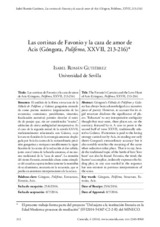Las cortinas de Favonio y la caza de amor de Acis (Góngora, Polifemo, XXVII, 213-216)
The Favonio’s Curtains and the Love Hunt of Acis (Góngora, Polifemo, XXVII, 213-216)
Autor
Román Gutiérrez, Isabel
Editor
Universidad de Córdoba, UCOPressFecha
2016Materia
Góngora y Argote, Luis de, 1561-1627Polifemo
Estructura
Favonio
Acis
Structure
METS:
Mostrar el registro METSPREMIS:
Mostrar el registro PREMISMetadatos
Mostrar el registro completo del ítemResumen
El análisis de la férrea estructura de la
Fábula de Polifemo y Galatea gongorina entendida
como poema narrativo (organización de las
secuencias, conexiones, paralelismos, simetrías,
focalización narrativa) permite desvelar el sentido
de pasajes que, sin ser considerados “reacios”,
adolecían de cierta ambigüedad interpretativa. Es
el caso de la segunda mitad de la estrofa XXVII,
tradicionalmente relacionada con Galatea, cuya
lectura en función de la estrategia amorosa desplegada
por Acis da cuenta de la extraordinaria precisión
gongorina y enriquece notablemente la significación
de la escena de la seducción al dar cabida,
junto con el tema de la batalla amorosa, al no menos
tradicional de la “caza de amor”. La mención
del viento Favonio, entendido ahora como cómplice
del cazador, expresa indirectamente la maniobra
de ocultamiento, necesaria en la secuencia, que se
perdía en anteriores interpretaciones de la octava. Góngora’s Fábula de Polifemo y Galatea
has always been acknowledged as a narrative
piece of poetry. However, to account for its rigid
structure discloses the significance of places.
‘Reluctant’ to any interpretative ambiguity
though they may seem, these places are, on the
contrary, featured by it. A case in point is the
second half of verse XXVII, traditionally related
to Galatea. If attention is paid to the loving
strategy carried out by Acis, its reading not only
shows Gongora’s extraordinary accuracy but it
also notably enriches the meaning of the scene
when seduction takes place. That is to say, beside
the traditional topic of the battle of love ‘love
hunt’ can also be found. Favonio, the wind, the
hunter’s accomplice, indirectly expresses the hiding
ploy, in any case needed in the sequence
but non-existent in previous interpretations of
the scene.

